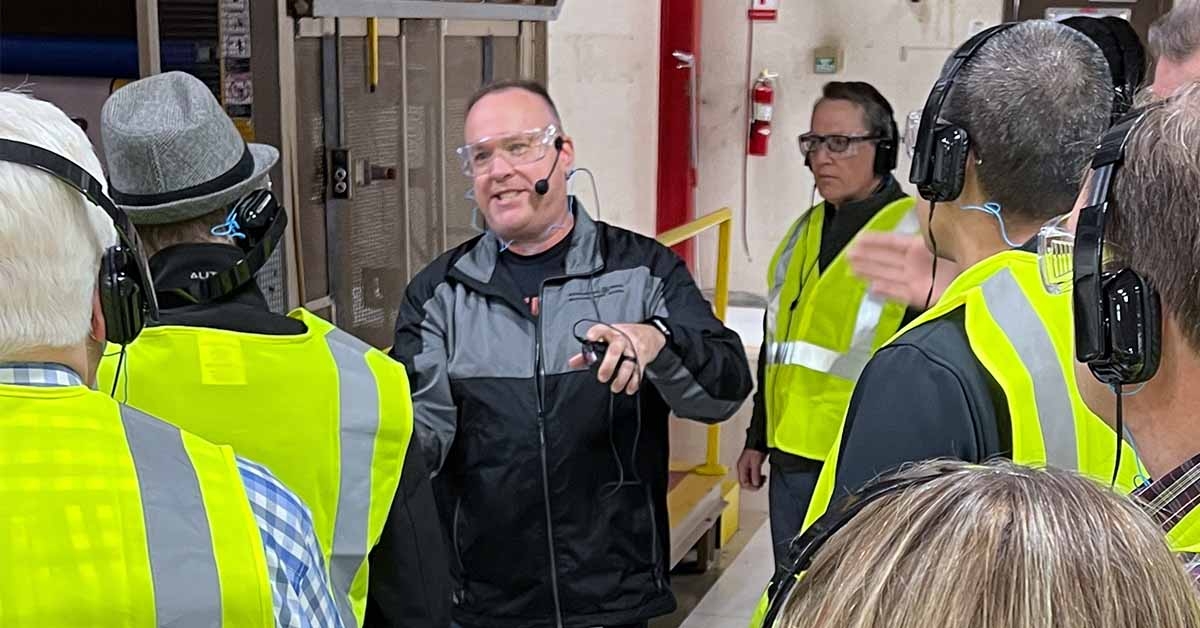It's Manufacturing Month! Back in the day, it was just called “Manufacturing Day.” But thank goodness someone had the good sense to capture the entire month – because there is NO WAY we could fit all of this into one day in the year!
Showcasing your organization to the public serves many purposes. It helps the industry as a whole when you shine the light on these valuable career paths. It helps YOUR organization as you can highlight openings and potential opportunities. It invigorates your current employees who share your mission and the contributions they make to advance the business. And it helps the community find careers that can break some families' poverty cycle. It’s a noble mission.
We know it can be a daunting task to undertake this noble mission, so we created a Plant Tour Checklist to help you out. It's also located on our Resources page on the website.
There are four key areas we think you should consider. Introducing the Four Stages of Hosting a Tour for Manufacturing Month:
Pre-planning
It’s important to get some questions answered as soon as you can. Here are a few key questions you should dig for:
How many guests are coming?
(And how many is a comfortable number for your environment?) The number of guests coming is a big one. It could change the format of the meeting dramatically. There will be many times when your partner does not know how many are coming – so in that case, just be sure to have a couple of ways to pivot, if the group size changes dramatically. If you have a group of 10 they might meet in a conference room. But if you have a group of 40, you might do stations and rotate the group.
What is the age group of the guests?
Middle School, High School, College age, Trade School? Adults? Families? Each group might be served better by a different activity. When in doubt, do your research, ask an employee with a child in that age group, or a teacher at the school what type of activities resonate best.
Are we aware of any synergies with the group?
Example: Do you have an employee that is a graduate of the touring school? A member of the community group? These first questions can set a few things in motion. When in doubt, try to pull in your younger employees when hosting student tours when possible. They can much more easily see themselves working here when they see a friend, a colleague, or a connection.
Planning
Now that you have done the back-work on the pre-planning, you can set the plan in motion. The plan typically starts with a map of the plant.
- What are the key areas that can be visited in the time allotted?
- How does the size of the group impact the areas of the tour and where the group gathers?
- What PPE will be needed to visit the key areas?
- How will attendees interact with the guide?
- Who is the best tour guide for the group?
- Perform a run-through with your notepad to see what areas need some extra attention.
- How many people do you have lined up to support the tour? Think about greeters, people to lead, people to lead the presentation, and people from multiple departments to answer questions.
- Do you have a place/system in place for where guests will put their coats/personal belongings?
- Will there be an audio/visual presentation?
Preparation
First impressions are important – once you have completed your run-through; it’s time to make sure the grounds inside and out are looking their best. From the moment the bus is pulling up on the property, there should be a review and cleaning. Walkways, shrubs, lawns, clippings, and debris are cleared a day or two in advance. In addition to the facility grounds, the production area should be cleaned and organized for the event. Incoming materials should be neatly stored near where production processes take place. And don’t forget all the areas where the group will be gathered. One last reminder- be sure that the restrooms have been thoroughly cleaned, as it’s inevitable that someone will need to use one!
Next is your list of giveaways or handouts. Name tags? Headsets? Snacks? If it’s a student group – food or swag goes a long way! Be sure to communicate what you are giving away with the leaders of the group in case there are dietary concerns or issues.
Presentation
The show is ready to begin! Many companies start with a small presentation about the company – the mission, the vision, the values, and the culture are all great things to share with the group – and then, of course, the star of the show – your product(s). Be sure to show the biggest picture of how your product fits into their world. If it isn't obvious, be sure to share how your product helps the average person. How does your product solve a problem and what are the real-life examples of the product in use today? And if your product lacks the WOW appeal - then dig in to how your company makes your employees' lives better. Key: think the biggest picture possible.
The Tour Itself
Be sure to provide exposure to different departments. Look at the various opportunities to highlight unique attributes of your company; things such as key stations, in-demand roles, or apprentices, or how the different areas impact the business. Think of ways you can add fun facts or data points – like “this department is responsible for 25% of our product line.” Or “this department just celebrated “x” (certain achievement).
But just as important as what you DO in your presentation is what you DON’T Do. When talking about safety like - keeping their hands and feet inside the yellow lines – avoid the temptation to add “we want you to come home with all your fingers and toes!” If you are concerned about the safety protocols, be sure to monitor the group and stress how important safety is to you. Don’t compare your generation, don’t talk about accidents, and don’t, please don’t, call young people lazy!
Follow Up
Once the tour is done, it’s a lost opportunity if you don’t follow up. Are there ways your company can engage with the school or group? Is there a business-advisory group at the school? Any job or career fairs you could get invited to? Any needs for guest speakers? Any job boards or career days? Any ways that you can donate or sponsor an event if you have the means to do so? The key in this last step is to offer to maintain a connection.
Best of luck, and Happy Manufacturing Month! Kathy Gilmore, President, VIA/GCAMP


